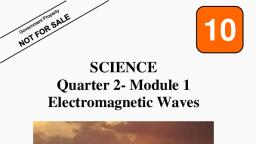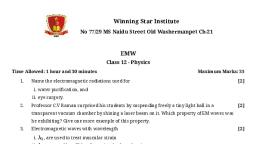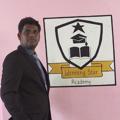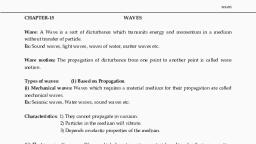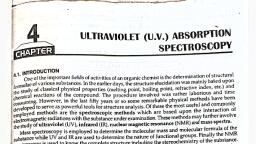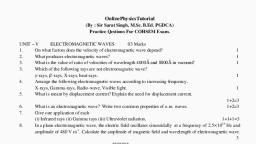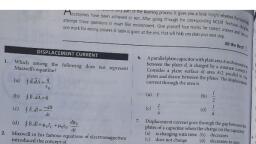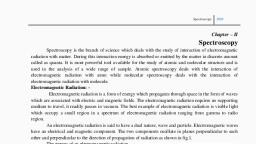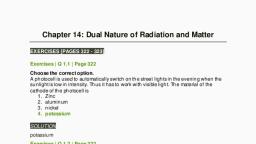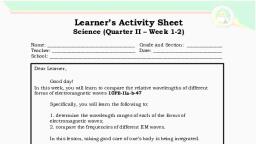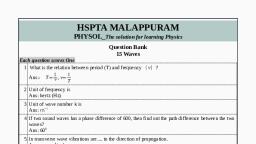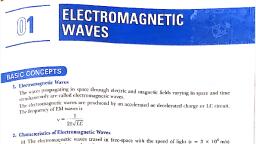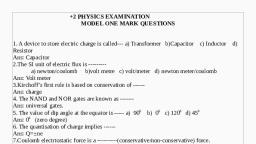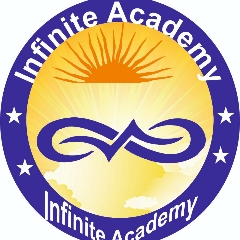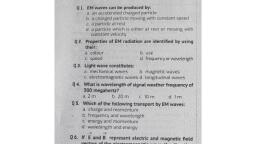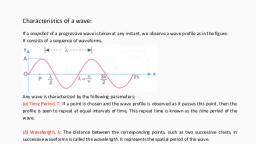Page 1 :
10, SCIENCE, Quarter 2- Module 1, Electromagnetic Waves, , Photo: Sunset, Location: Kiburiao, Quezon, Bukidnon, Captured by: Elmar M. Dongallo, , Department of Education ● Republic of the Philippines
Page 2 : Science – Grade 10, Alternative Delivery Mode, Quarter 2 – Module 1: Electromagnetic Waves, First Edition, 2020, Republic Act 8293, section 176 states that: No copyright shall subsist in any, work of the Government of the Philippines. However, prior approval of the government, agency or office wherein the work is created shall be necessary for exploitation of such, work for profit. Such agency or office may, among other things, impose as a condition, the payment of royalties., Borrowed materials (i.e., songs, stories, poems, pictures, photos, brand names,, trademarks, etc.) included in this module are owned by their respective copyright, holders. Every effort has been exerted to locate and seek permission to use these, materials from their respective copyright owners. The publisher and authors do not, represent nor claim ownership over them., Published by the Department of Education – Division of Bukidnon, Schools Division Superintendent: Randolph B. Tortola, PhD, CESO IV, Development Team of the Module, Author, Content Editor, Language Editor, Reviewers, Illustrator and Layout Artist, Management Team, Chairperson, Co-Chairpersons, , Members, , :, :, :, :, :, , Elmar M. Dongallo, Mark Windel R. Doño, Jayrod F. Eslao, Marria Luisa M. Casiño, Ellen A. Azuelo, PhD, Rejynne Mary L. Ruiz, PhD, , : Arturo B. Bayocot, PhD, CESO III, Regional Director, : Victor G. De Gracia Jr., PhD, CESO V, Assistant Regional Director, : Randolph B. Tortola, PhD, CESO IV, Schools Division Superintendent, : Shambaeh A. Abantas-Usman, PhD, Assistant Schools Division Superintendent, : Mala Epra B. Magnaong, Chief ES, CLMD, : Neil A. Improgo, EPS-LRMS, Bienvenido U. Tagolimot, Jr., EPS-ADM, Elbert R. Francisco, CID Chief, Ellen A. Azuelo, EPS-Science, Rejynne Mary L. Ruiz, LRMS Manager, Jenny B. Timbal, PDO II, Shella O. Bolasco, Librarian II, , Printed in the Philippines by, Department of Education – Division of Bukidnon, Office Address:, Fortich Street, Malaybalay City, Bukidnon, Telefax:, (088) 813-3634, E-mail Address:,
[email protected]
Page 3 :
10, SCIENCE, Quarter 2- Module 1, Electromagnetic Waves, , This instructional material was collaboratively developed and reviewed, by educators from public schools. We encourage teachers and other education, stakeholders to email their feedback, comments, and recommendations to the, Department of Education at bukidnon@ deped.gov.ph., We value your feedback and recommendations., , Department of Education ● Republic of the Philippines
Page 4 :
Table of Contents, Cover Page, Copyright Page, Title Page, Table of Contents, What This Module Is About, What I Need to Know, What I Know, Lesson 1: Nature of Electromagnetic Waves, What I Need to Know, What I Know, What’s In, What’s New, What Is It, What’s More, What I Have Learned, What I Can Do, Assessment, Additional Activities, , 1, 1, 2, 2, 4, 5, 6, 6, 7, 7, , Lesson 2: The Proponents of Electromagnetic Wave Theory, What I Need to Know, What I Know, What’s In, What’s New, What Is It, What’s More, What I Have Learned, What I Can Do, Assessment, Additional Activities, , 9, 9, 10, 10, 12, 14, 15, 15, 16, 16, , Lesson 3: Electromagnetic Spectrum: Wavelength and Frequency, What I Need to Know, What I Know, What’s In, What’s New, What Is It, What’s More, What I Have Learned, What I Can Do, Assessment, Additional Activities, , 17, 17, 18, 19, 20, 22, 23, 23, 23, 24, , Summary, Post Test, Answer Keys, References, , 25, 26, 28, 29
Page 5 :
What This Module Is About, Introductory Message:, Welcome to the Science 10 Alternative Delivery Mode (ADM) Module on, Electromagnetic Waves! An electromagnetic (EM) wave refers to the disturbance in a, field that carries energy and does not require a medium to travel. These EM waves, are formed when an electric field comes in contact with a magnetic field. These include, radio waves, microwaves, infrared, visible light, ultraviolet, X-rays and gamma rays., , To the Teachers:, This module was collaboratively designed, developed and reviewed by educators from, public schools to assist you, the teacher or facilitator, in helping the learners meet the, standards set by the K to 12 Curriculum while overcoming their personal, social, and, economic constraints in schooling., As a facilitator, you are expected to orient the learners on how to use this module. You, also need to keep track of the learners' progress and allow them to manage their own, learning for optimal development and understanding. Furthermore, you are expected, to encourage and assist the learners as they do the tasks included in this module., , To the Parents:, This module was designed to provide your children with fun and meaningful, opportunities for guided and independent learning at their own pace and time., As vital partners in education, your support to your children’s learning at home is a, great factor to ensure that they will become successful in what they do. As parents,, you are expected to monitor your children’s progress as they accomplish the tasks, present in this module and ensure that they will practice learning independently., , To the Learners:, This learning resource hopes to engage you into guided and independent learning, activities at your own pace and time. This also aims to help you acquire the needed, 21st century skills while taking into consideration your needs and circumstances., It is our objective that you will have fun while going through this material. Take charge, of your learning pace and in no time, you will successfully meet the targets and, objectives set in this module which are intended for your ultimate development as a, learner and as a person., , -, , From the Science 10 Module Development Team
Page 6 :
This module contains the following parts with their corresponding icons:, , What I Need to Know, , This gives you an idea on what skills or, competencies you are expected to learn in, each lesson., , What I Know, , It includes an activity that aims to check your, prior knowledge on the lesson you are about, to take. If you get all the answers correct, (100%), you may decide to skip the lesson., , What’s In, , This serves as a brief drill or review to help, you link the current lesson with that to the, previous one., , What’s New, , It offers a new lesson by introducing it, interestingly through a story, a song, a poem,, a problem opener, an activity or a situation., , What Is It, , This provides a brief discussion of the lesson., This aims to help you discover and, understand new concepts and skills., , What’s More, , This comprises activities for independent, practice to solidify your understanding and, skills on the current topic. You may check the, answers to the exercises using the Answer, Key found at the end of the module., , What I Have Learned, , This, includes, questions, or, blank, sentences/paragraphs to be filled in to, process what you have learned from the, lesson., , What I Can Do, , It delivers, an activity which will help you, iii, transfer your new knowledge or skill into real, life situations or concerns., , Assessment, , This aims to evaluate your level of mastery in, achieving the learning competencies., , Additional Activities, , This enriches your knowledge or skill of the, lesson learned. It also tends to the retention of, the learned concepts., , Answer Key, , This contains all of the answers to all activities, and exercises present in this module.
Page 7 :
At the end of this module, you will also find:, References, , This shows the list of, developing this module., , all sources used in, , Before using this module, please take time to read the following guidelines and, reminders:, 1. Use the module with care. Do not put unnecessary mark/s on any part of the, module. Use a separate sheet of paper in answering the exercises., 2. Do not forget to answer the What I Know section before moving on to the next, activities included in this module., 3. Read the instructions carefully before doing each task., 4. Observe honesty and integrity in doing the tasks and in checking your answers., 5. Finish the task at hand before proceeding to the next., 6. Return this module to your teacher/facilitator once you are through with it., If you encounter any difficulty in answering any of the activities, do not hesitate to, consult your teacher or facilitator. Always bear in mind that you are not alone., We hope that through this material, you will experience meaningful learning and, be able to gain a deeper understanding of the relevant competencies. You can do it!, , Module Overview, When this material was designed, your best interest as a learner was given the, highest attention. For this specific module, you are expected to master the nature of, electromagnetic waves. The scope of this module permits it to be used in many, different learning situations. The language it uses recognizes the diverse vocabulary, level of students. Moreover, the lessons are arranged to follow the standard sequence, of the course. But the order in which you read them can be changed to correspond, with the textbook you are now using., The module is divided into three lessons, namely:, •, •, •, , Lesson 1 – Nature of Electromagnetic Waves, Lesson 2 – The Proponents of Electromagnetic Wave Theory, Lesson 3 – EM Waves: Frequencies and Wavelengths, , After going through this module, you are expected to:, 1. Describe how an electromagnetic (EM) wave is produced and propagated;, 2. Find out who the significant proponents are on the formulation of, electromagnetic theory; and, 3. Compare the relative frequencies and wavelengths of each EM wave.
Page 8 :
Let us check first your understanding on the concept of electromagnetic waves by, answering a pretest., , What I Know (Pretest), , Directions: Choose the CAPITAL LETTER of the best answer. Write the chosen, letter on a separate sheet of paper., 1. How are electromagnetic waves produced?, A. Any disturbance, B. Currents, , C. Vibrating charge, D. Voltage source, , 2. In the electromagnetic wave, what is the direction of the propagation of the, wave?, A. Always to the right, B. Cannot be determined, C. Parallel to electric and magnetic field directions, D. Perpendicular to the electric and magnetic field directions, 3. Which of the following forms of electromagnetic waves has the widest, frequency range?, A. Microwave, C. Ultraviolet, B. Radio waves, D. X-ray, 4. What happens to the frequency of the electromagnetic wave if its wavelength, increases?, A. It decreases., C. It remains the same., B. It increases as well., D. None of the above., 5. What is the speed of the electromagnetic wave in a vacuum?, A. Zero, B. Always the same as the speed of light, C. Changing depending on the value of its wavelength, D. none of the above, 6. Who contributed in developing equations that showed the relationship, of electricity and magnetism?, A. André-Marie Ampere, C. James Clerk Maxwell, B. Heinrich Hertz, D. Michael Faraday, 7. Who showed the experimental evidence of electromagnetic waves and their, link to light?, A. André-Marie Ampere, C. James Clerk Maxwell, B. Heinrich Hertz, D. Michael Faraday
Page 9 :
8. Which type of wave has the shortest wavelength?, A. Gamma ray, C. Ultraviolet, B. Microwave, D. X-ray, 9. What is the other term for electromagnetic waves?, A. Electric waves, C. Mechanical waves, B. Longitudinal waves, D. Transverse waves, 10. All EM waves have the same speed., A. True, B. False, 11. Which of the following correctly lists electromagnetic waves in the order from, the longest to the shortest wavelength?, A. Gamma rays, ultraviolet, infrared, microwaves, B. Microwaves, ultraviolet, visible light, gamma rays, C. Radio waves, infrared, gamma rays, ultraviolet, D. Radio waves, infrared, visible light, X-rays, 12. How is the wavelength of infrared differs from the wavelength of ultraviolet, waves?, A. Longer, C. The same, B. Shorter, D. None of the above, 13. What is the main difference between a radio wave and a light wave?, A. Speed, C. Both A and B, B. Wavelength, D. None of the above, 14. Which of the following is NOT an electromagnetic wave?, A. Infrared, C. Sound, B. Light, D. Radio, 15. What is the frequency range of UV radiation?, A. 3.5x109 – 3x1011 Hz, C. 7.5x1014 – 3x1016 Hz, 11, 14, B. 3.5x10 – 4x10 Hz, D. 7.5x1016 – 3x1019 Hz
Page 10 :
Lesson, , 1, , Nature of Electromagnetic, Waves, What I Need to Know, , In this lesson, you will be introduced to the nature of electromagnetic waves, and on how they are produced and transmitted. You are also expected to be able to, explain how these waves are considered to be comprised of both electric and magnetic, fields., The activities found in this lesson are crafted with the goal of allowing you to, ponder easily and confidently on the concept of electromagnetic waves., So, explore and have fun in learning!, , What I Know, Check your understanding!, TRUE OR FALSE: Write the word TRUE if the statement is correct, and FALSE, if it is not. (3 points each). Write your answer on a separate sheet of paper., 1., 2., 3., 4., , Electromagnetic waves transfer energy through a vacuum., A wave is a disturbance that transfers energy., EM waves travel at the speed of 4x108 m/s., Electromagnetic waves are transverse waves consisting of changing electric, fields and changing magnetic fields., 5. Most EM waves have the same speed., , 1
Page 11 :
What’s In, , In the previous lesson, you have learned about the interrelationship between, electricity and magnetism. You were also able to discover how an electric field could, create a magnetic field and vice versa., As a review, a magnetic field is created around a wire that conducts electric, current. A coiled wire, known as a solenoid, acts as a magnet when current flows, through it. A solenoid with a core of iron acts as a strong magnet which is called as, electromagnet., Based on what you have learned previously, how can you describe, electromagnetism?, , Notes to the Teacher, You may instruct the students to write down their answers on, their activity notebook., , What’s New, , This time, you will be introduced to the nature of an electromagnetic (EM) wave., As its name suggests, it is considered to be of both electric and magnetic in nature. In, other words, an electromagnetic wave contains an electric field and a magnetic field., These fields are not made up of matter similar to what is in a football field. Instead,, electric and magnetic fields are the regions through which the push or pull of charged, particles and magnets is exerted. Charged particles and magnets can push or pull, certain objects without even touching them., , 2
Page 12 :
To understand this idea further, the next activity can help you out. Try making, this wave machine to see how all the different kinds of waves move!, , Activity 1.1: Building a Wave Machine, Objective:, To observe the propagation of a wave., Materials:, Monobloc Chairs– 2 pcs, Scotch Tape or Masking tape, Sticks (from stickbroom or BBQ sticks) – 15 pcs, Modelling Clay- 30 pcs (alternative NIPS candy or any softy small circle, objects with same size and weight that can hold the sticks), Any books to hold the tape– 2 pcs, Procedure:, 1. Gather all materials needed for the activity, and then place the two chairs about 1 meter, apart from each other., 2. Stretch a piece of scotch tape or masking, tape to both sides of the chair and place any, books to hold the ends of the tape. Make, sure that the sticky part of the tape is facing, upward., 3. Leaving about one (1) foot of tape empty on, each end, center the sticks from the, stickbroom or barbecue sticks along the, tape, placing each one 1 ½ inches away, from the one., 4. Make a 30 small circles of modelling clay, with the same size and weight that can hold, the sticks or if you don’t have a modelling, clay you can use Nips candy or any softy, small circle objects with same size and, weight that can still hold the sticks. Then,, place the circled modeling clay/nips into the, ends of the stick by pushing them through, Actual Photos of the Activity, the stick., Performed and Captured by: Elmar M. Dongallo, 5. Tap the stick on one end of the tape., Do tapping for five times or at your own desires. Observe what happen., Guide Questions:, 1. When you tapped the stick on one end of the tape, did you see a wave that, formed and rolled down the line? Write your observations., 2. How is a wave propagated and produced?, 3. Remove half of the circled modelling clay/nips from both ends of the line., Now, tap one stick. Does the wave still travel along the line? Write your, observations on a separate sheet of paper., You may check your answers after performing all the activities in this lesson., 3
Page 13 :
What Is It, Nature of Electromagnetic Waves, How are electromagnetic waves produced?, Electromagnetic waves are produced by a charge that changes its direction, or speed. Electrons are charged particles that can produce electric and magnetic, fields. But in order to create the vibrating electric and magnetic fields that are the, characteristics of an electromagnetic wave, electrons must move. A charged particle,, such as an electron, moves back and forth, or vibrate. A changing magnetic field, produces an electric field and in the same manner, a changing electric field produces, a magnetic field., After knowing about how electromagnetic waves are produced, this time, read, on to be informed on how they move into different directions., An electromagnetic wave is made up of an electric field and a magnetic field, positioned at right angles to each other and to the direction of motion of the wave (see, Figure 1.1). Since these fields are located at the right angles to the direction of motion, of the wave, electromagnetic waves are considered as transverse waves. This means, that both electric and magnetic fields oscillate perpendicular to each other and to the, direction of the propagating wave., , https://www.toppr.com/guides/physics/communication-systems/propagation-of-electromagnetic-waves/, , Figure 1.1 In a transverse wave, the direction of the wave energy moves into a right, angle to the electric and magnetic fields., 4
Page 14 :
Like other waves, such as water waves and waves on a rope, electromagnetic, waves carry energy from one place to another. But unlike other waves,, electromagnetic waves do not carry energy by causing matter to vibrate. It is the, electric and magnetic fields that vibrate. This explains why electromagnetic waves can, travel in a vacuum (where there is no matter). But it does not mean that, electromagnetic waves cannot travel through a medium. They certainly can. Light, for, example, can be transmitted with a medium - as through the atmosphere - or without, a medium - as through space., Electromagnetic waves travel in a vacuum at a speed of 3x108 m/s and denoted, as c, the speed of light. The speed is slightly slower in air, glass, and any other, material. To appreciate just how great this speed is, consider this: Light from the sun, travels 150 million kilometers to Earth in about 8 minutes!, Nothing known in the universe travels faster than the speed of light. Since, all EM waves have the same speed which is equal to the speed of light, this means, that as the wavelength decreases, the frequency of the wave increases., Properties of Electromagnetic Waves, Electromagnetic waves are known to possess the following properties:, 1. They are produced by accelerated or oscillating charge., 2. They do not require any material or medium for propagation., 3. They travel in free space at the speed of 3x108 m/s., , 5
Page 15 :
What’s More, , Directions: Unscramble the words in Box B and match this words to fill them, into the appropriate blanks in Box A to complete the statements below. Write, the answer on a separate sheet of paper. (3pts each), , Box A, 1. A moving charge creates _____________., 2. A changing magnetic field causes a changing, ___________, 3. The successive production of electric and, magnetic fields results to the creation of, ________ wave., 4. An EM wave propagates _____________ from, the source., 5. Electromagnetic waves do not need, ____________ to transfer energy., , Box B, Scrambled Word/s, A., B., C., D., E., F., , What I Have Learned, Check your understanding!, Answer the following questions., 1., 2., , What is an electromagnetic field?, How is an EM wave produced and propagated?, , 6, , ME, PEEDS, OESTCJB, WARDOUT, CTNGMAEI, EEILCTRC, , LDFIE, IEDFL
Page 16 :
What I Can Do, , Let’s apply what you have learned!, Electromagnetic Waves in Your Life, 1. How do electromagnetic waves play an important role in your life? Explain, your answer. Write your answer on a separate sheet of paper., , Assessment, , Check your understanding!, TRUE OR FALSE: Write the word TRUE if the statement is correct, and FALSE, if it is not. (3 points each). Write your answer on a separate sheet of paper., 1. Most EM waves have the same speed., 2. EM waves travel at the speed of 4x108 m/s., 3. Electromagnetic waves are transverse waves consisting of changing, electric fields and changing magnetic fields., 4. Electromagnetic waves transfer energy through a vacuum., 5. A wave is a disturbance that transfers energy, , 7
Page 17 :
Additional Activities, , Let’s extend what you have learned!, Directions:, 1. Inside your house, look around four devices and appliances that you use, everyday., 2. Name four (4) objects that you see which can produce electromagnetic, waves., 3. Write the uses/applications of the objects that you have listed., 4. Write your answer on a separate sheet of paper., , 8
Page 18 :
Lesson, , 2, , The Proponents of, Electromagnetic Wave Theory, , What I Need to Know, In this lesson, you will learn how the study of electromagnetic waves came to, be. It is here that you will find out who were the proponents on the formulation of the, electromagnetic theory. Furthermore, this lesson will enable you to gain more, information about the scientists who made great contributions to the development of, this theory., , What I Know, Check your understanding!, MATCHING TYPE, Directions: Match the scientists given below to their significant contributions., Write the LETTER only of your answer on a separate sheet of paper., (3pts each), Scientists, ________1. André-Marie Ampere, , ________2. Michael Faraday, , ________3. Heinrich Hertz, ________4. James Clerk Maxwell, ________5. Hans Christian Oersted, , Contribution, A. Contributed in developing equations, that showed the relationship of electricity, and magnetism, B. Showed experimental evidence of, electromagnetic waves and their link to, light, C. Demonstrated the magnetic effect based, on the direction of a current, D. Formulated the principle behind, electromagnetic induction, E. Showed how a current - carrying wire, behaves like a magnet, , 9
Page 19 :
What’s In, In the previous lesson, you have learned about the nature of an electromagnetic, wave. You were also able to discover how accelerating electrons can produce, electromagnetic waves and that these waves are a combination of electric and, magnetic fields. In addition, you have also studied that EM waves transfer energy, through a vacuum at the speed of 3x108 m/s which is the same as the speed of light., From what you have learned, what again is an electromagnetic wave?, , Notes to the Teacher, You may instruct the students to write down their, answers on their activity notebook., , What’s New, The history of Electromagnetic Wave Theory begins with ancient measures to, understand atmospheric electricity, in particular, lightning. People then had little, understanding of electricity and were unable to explain the phenomena. Scientific, understanding about the nature of electricity grew throughout the eighteenth and, nineteenth centuries through the work of researchers., During the19th century, it had become clear that electricity and magnetism were, related, and their theories were unified: Whenever charges are in motion, electric, current results, and magnetism is due to electric current. The source for electric field, is electric charge, whereas that for magnetic field is the electric current (charges in, motion)., Through the years, the advancement on the knowledge regarding, electromagnetic waves led us to a modern technological world., 10
Page 20 :
The next activity will help you find out the distinguished scientists who made great, contributions in the development of the Electromagnetic Wave Theory., , Activity 2.1: Electromagnetic Wave Theory Comic Strip, Directions: Read the comic strip below and answer the questions that follow on a, separate sheet of paper., , Figure 2.1 EM wave theory comic strip, Source: https://www.storyboardthat.com/storyboards/ahmad33294/electromagnetic-wave-theory-comic-strip, , Guide Questions:, 1. What is the contribution of Ampere in the Electromagnetic Wave Theory?, 2. If you were one of the group of friends talking in this comic strip, who do you, think would be your favorite scientist? Why?, , 11
Page 21 :
What Is It, ELECTROMAGNETIC WAVE THEORY, When you studied wave motion, you have known that a disturbance produces, waves that can be transmitted through a medium. In the same way, electromagnetic, waves are also produced by a disturbance caused by a vibrating charge. When the, charge is moved, the electric field around it is changed., Recall Oersted’s discovery which states that “A changing electric field, produces a magnetic field”. A changing magnetic field is therefore produced around, the vibrating charge. In turn, this changing magnetic field produces an electric field., Do you remember Faraday’s Law? The cycle goes on. The changing magnetic, and electric fields are perpendicular to each other and to their direction of propagation., Therefore, they are seen as transverse waves., About 150 years ago, James Clerk Maxwell theorized that this mutual, generation and propagation of electric field and magnetic field can be conceived as a, form of moving energy carried by what he called as electromagnetic wave. So, if this, is just like any wave, does it mean that it travels through a medium? No., Electromagnetic wave traverses empty space! However, Maxwell did not believe that, electromagnetic wave propagates in space under any condition. He supposed that it, must move at a certain speed. He calculated the speed of the wave based on, Faraday’s theoretical assumptions and experiments and concluded that the speed is, 3.0 x 108 m/s and denoted as c – the same as the speed of light! He therefore, proposed that light is a form of electromagnetic wave. Unfortunately, at that time, no, experiment was done to verify his accounts. But after Faraday’s death, Heinrich Hertz, designed an experimental set-up that enabled him to generate and detect, electromagnetic waves., , Proponents on the Formulation of EM Wave Theory, The following prominent scientists each made a significant contribution in, resolving how electromagnetic waves behave., James Clerk Maxwell (1876), an English scientist who developed a scientific, theory to better explain electromagnetic waves. When Maxwell used this field theory, to assume that light was an electromagnetic wave, and then correctly deduced the, finite velocity of light, it was a powerful logical argument for the existence of the, electromagnetic force field., , 12
Page 22 :
He noticed that electrical fields and magnetic fields can couple together to form, electromagnetic waves. Maxwell discovered that a changing magnetic field will induce, a changing electric field and vice versa., Heinrich Hertz, a German physicist who applied Maxwell’s theories to the, production and reception of radio waves. The unit of frequency of a radio wave - one, cycle per second - is named the hertz, in honor of Heinrich Hertz. He proved the, existence of radio waves in the late 1880s. He used two rods that served as a receiver, and a spark gap as the receiving antennae. Where the waves were picked up, a, corresponding spark would jump. Hertz showed in his experiments that these signals, possessed all of the properties of electromagnetic waves., Michael Faraday (1791-1867) is probably best known for his discovery of, electromagnetic induction. His contributions to electrical engineering and, electrochemistry or due to the fact that he was responsible for introducing the concept, of field in physics to describe electromagnetic interaction are enough for him to be, highly recognized. But perhaps, it is not so well known that he had also made, fundamental contributions to the electromagnetic theory of light., André-Marie Ampère made the revolutionary discovery that a wire carrying, electric current can attract or repel another wire next to it that’s also carrying electric, current. The attraction is magnetic, but no magnets are necessary for the effect to be, seen. He went on to formulate Ampere’s Law of Electromagnetism and produced the, best definition of electric current during his time., Hans Christian Oersted, a Danish physicist and chemist who discovered that, the electric current in a wire can deflect a magnetized compass needle, a phenomenon, the importance of which was rapidly recognized and which inspired the development, of electromagnetic theory., , The Basic Principles of EM Wave Theory, After years of rigorous studies and experiments, the following principles came, about to explain the Electromagnetic Wave Theory., 1. Many natural phenomena exhibit wave-like behaviors. All of them – water waves,, earthquake waves, and sound waves require a medium to propagate. These are, examples of mechanical waves., 2. Light can also be described as a wave – a wave of changing electric and magnetic, fields that propagate outward from their sources. These waves, however, do not, require a medium to propagate., 3. They propagate at 300,000,000 meters per second through a vacuum., , 13
Page 23 :
4. Electromagnetic waves are transverse waves. In simpler terms, the changing, electric and magnetic fields oscillate perpendicular to each other and to the, direction of the propagating waves., These changing electric and magnetic fields generate each other through, Faraday’s Law of Induction and Ampere’s Law of Electromagnetism. These, changing fields dissociate from the oscillating charge and propagate out into, space at the speed of light., 5. When the oscillating charge accelerates, the moving charge’s electric fields, change, too., , What’s More, Activity 2.2: CONCEPT WEB, Directions: Using the information you have gathered previously, make a concept web, showing the contributions of the scientists listed below. Write your answers on, a separate sheet of paper., A., B., C., D., E., , André-Marie Ampere, Michael Faraday, Heindrich Hertz, James Clerk Maxwell, Hans Christian Oersted, , Concept Web, A. André-Marie, Ampere, , B. Michael Faraday, , Electromagnetic, Wave Theory, , E. Hans Christian, Oersted, , D. James Clerk, Maxwell, , C. Heinrich Hertz, , 14
Page 24 :
What I Have Learned, , Let’s check your understanding!, Answer this question., 1. How did the Electromagnetic Wave Theory result to the advancement of a, modern technological world? Explain your answer and write it on a separate, sheet of paper., , What I Can Do, , Answer the question below., If you are one of the scientists mentioned in this lesson, how can you prove to, other people that your theory should become a law? Write your opinion on a, separate sheet of paper., ___________________________________________________________, ___________________________________________________________________, ___________________________________________________________________, ___________________________________________________________________, ___________________________________________________________________, ___________________________________________________________________, ___________________________________________________________________, ___________________________________________________________________, ___________________________________________________________________, ___________________________________________________________________, ___________________________________________________________________., , 15
Page 25 :
Assessment, , MATCHING TYPE, Directions: Match the scientists listed below to their corresponding contributions., Write the LETTER only of your answer on a separate sheet of paper., 3pts each, Scientists, ________1. André-Marie Ampere, , ________2. Michael Faraday, ________3. Heinrich Hertz, ________4. James Clerk Maxwell, ________5. Hans Christian Oersted, , Contribution, A. Contributed in developing equations, that showed the relationship of electricity, and magnetism, B. Showed experimental evidence of, electromagnetic waves and their link to light, C. Demonstrated the magnetic effect based, on the direction of a current, D. Formulated the principle behind, electromagnetic induction, E. Showed how a current-carrying wire, behaves like a magnet, , Additional Activities, , Create your own comic strips citing the scientists’ contribution to the, development of the Electromagnetic Wave Theory., , 16
Page 26 :
Lesson, , 3, , EM Waves: Frequencies and, Wavelengths, What I Need to Know, , In this lesson, you will learn about the characteristics of EM waves. You will, also find here their physical wave features: frequency and wavelength. Moreover,, this lesson enables you to gain more information on how the different types of EM, waves are arranged according to its wavelength and frequency., , What I Know, , Check your understanding!, MULTIPLE CHOICE, Direction: Choose the letter of the best answer. Write the CAPITAL LETTER, only of your answer on a separate sheet of paper. 3pts each., 1. Which EM wave has the highest frequency than others?, A. Microwaves, C. UV radiation, B. Radio waves, D. Visible light, 2. What is the frequency range of UV radiation?, A. 3.5x109 – 3x1011 Hz, C. 7.5x1014 – 3x1016 Hz, B. 3.5x1011 – 4x1014 Hz, D. 7.5x1016 – 3x1019 Hz, , 17
Page 27 :
3. What is the wavelength of a wave with a frequency of 3x109 Hz?, A. 1.0x10-1 m, C. 1.0x102 m, B. 1.0x10-2 m, D. 3.5x101 m, 4. Radio wave is _________ in wavelength than the gamma ray., A. Higher, C. Lower, B. Longer, D. Smaller, 5. What happens to the frequency of the electromagnetic wave if its wavelength, increases?, A. It decreases., C. It remains the same., B. It increases as well., D. None of the above., , What’s In, In the previous lesson, you have learned about the Electromagnetic Wave, Theory and its significant proponents who made its development possible., Before we will proceed to the next lesson, jot down your new insights or learning, about the Electromagnetic Wave Theory. Write your answer on a separate sheet of, paper., , Notes to the Teacher, You may instruct the students to write down their, answers on their activity notebook., , 18
Page 28 :
What’s New, Now that you have acquired a deeper understanding on what electromagnetic, waves are, you might be wondering how sunlight is different from X-rays if both are, electromagnetic waves that travel at the same speed. Electromagnetic waves, like all, types of waves, are described by their physical wave features: amplitude, wavelength,, and frequency. These are the characteristics that can vary and thereby produce many, different kinds of electromagnetic waves., An electromagnetic wave is arranged according to its wavelength and, frequency. The term frequency describes how many waves per second a wavelength, produces. On the other hand, the wavelength measures the length of an individual, wave in meters., The next activity will enable you to explore the different types of EM waves, based on their wavelengths and frequencies., Activity 3.1: When Frequency and Wavelength Matters!, Objective:, •, , Determine the frequency and wavelength ranges of the different types of, electromagnetic waves, , Material:, • EM wave images, activity notebook, pen, Procedure:, 1. Study the image of the electromagnetic spectrum very closely., 2. Determine the frequency and wavelength ranges of the different types of, electromagnetic waves., , Figure 3.1: The electromagnetic waves’ wavelengths and frequencies, , Figure 3.1 The EM Waves’ wavelength and frequency, Source: https://www.slideshare.net/dionesioable/module-17-wireless-communication, , 19
Page 29 :
Copy the table and enter your data on a separate sheet of paper., Table 3.1 Electromagnetic Waves’ Wavelength and Frequency, EM Wave, Frequency, Wavelength, Range (hertz), Range (meters), Radio Waves, Microwaves, Infrared, Visible Light, Ultraviolet, X-rays, Gamma rays, , What is It, EM Waves: Frequencies and Wavelengths, The electromagnetic waves (EM) are often arranged in the order of, wavelength and frequency in what is known as the electromagnetic spectrum., Because all EM waves travel at the same speed, if the frequency of a wave changes,, then the wavelength must change as well. Waves with the longest wavelengths have, the lowest frequencies while the waves with the shortest wavelengths have the highest, frequencies. The amount of energy carried by an electromagnetic wave increases with, its frequency., Arranged according to increasing frequency, the EM spectrum displays the, following waves: radio waves, microwaves, infrared, visible light, ultraviolet, Xrays, and gamma rays at the high-frequency (short wavelength) end. It is important, to note that these waves do not have an exact dividing region., , Figure 3.2: The EM spectrum (Source: https://www2.lbl.gov/MicroWorlds/ALSTool/EMSpec/EMSpec2.html), , 20
Page 30 :
Since all EM waves travel at the speed of light, then the spectrum of, wavelengths is exactly opposite to the spectrum of frequencies. In other words,, wavelength and frequency are inversely proportional to each other. As frequencies, increase on the EM spectrum, wavelengths decrease. So, that means radio waves, have the longest wavelengths and gamma rays have the shortest., The different types of electromagnetic waves are defined by the amount of, energy carried by their photons. Photons are bundles of wave energy. From among, the EM waves, gamma rays carry photons of high energies while radio waves own, photons with the lowest energies. With regard to the wavelength properties, radio, waves can be likened to the size of a football field while gamma rays are as small as, the nuclei of an atom. Gamma rays, X-rays, and high ultraviolet are classified as, ionizing radiation as their photons have enough energy to ionize atoms, causing, chemical reactions., All electromagnetic waves can travel through a medium but unlike other types, of waves, they can also travel in a vacuum or empty space. They travel in a vacuum, at the speed of 3x108 m/s and denoted as c, the speed of light. The wave speed,, frequency and wavelength are related as shown in the following equation:, v = λf, , where v is the wave speed, expressed in meters per second, the frequency f is, expressed in Hertz and the wavelength λ is expressed in meters., , Sample Problems:, (Assume that the waves propagate in a vacuum.), 1. What is the frequency of radio waves with the wavelength of 20 m?, Given: v = c = 3x108 m/s (constant), λ = 20 m (2.0x101 m), f =?, Solution:, Formula:, Derived:, , v=c=f, f=c, λ, , = 3x108m/s, 2.0x101 m, = 1.5x10(8-1) Hz, (Answer) f = 1.5x107Hz, 21
Page 31 :
2. What is the frequency of light waves with the wavelength of 5x10 -7 m?, Given: v = c = 3x108 m/s (constant), λ = 5x10-7 m, f, =?, Solution:, Formula:, Derived:, , v=c=f, f=c, λ, = 3x108m/s, 5x10-7 m, = 0.6x10(8-(-7) Hz, = 6x10(15-1) Hz, , (Answer) f = 6x1014Hz, , What’s More, , Direction: Compare the following EM waves and fill in the missing word to, complete the statement. Use the descriptions such as lower, higher, shorter, and longer. Write your answer on a separate sheet of paper., 1. Radio wave is, _________ in, wavelength than the, gamma ray., 2. Microwave is, __________ in, frequency than, infrared., 3. Infrared is, _____________ in, wavelength than, visible light., 4. X-ray is ___________, in wavelength than, gamma ray., 5. Gamma ray is, ___________ in, frequency than, microwave., , Fig.3.3. The EM waves wavelengths and frequencies, , Source: https://www.slideshare.net/dionesioable/module- 17wireless-communication, , 22
Page 32 :
What I Have Learned, Say something on this!, Write your answer on a separate sheet of paper., 1. How is an electromagnetic spectrum organized in terms of its frequency and, wavelength?, 2. What happens to the wavelength of an electromagnetic wave if its frequency, increases?, , What I Can Do, Try to solve this problem!, Show your solutions on a separate sheet of paper., (Assume that the waves propagate in a vacuum.), 1. What is the frequency of a micro wave that has a wavelength of 1.5x102 m?, Given: v, = c = 3x108 m/s (constant), λ, = 1.5x102 m, f, =?, , Assessment, , MULTIPLE CHOICE, Direction: Choose the letter of the best answer. Write the CAPITAL LETTER, only on a separate sheet of paper. 3pts each, 1. What happens to the frequency of the electromagnetic wave if its wavelength, increases?, A. It decreases., C. It remains the same., B. It increases as well., D. None of the above., 2. What is the wavelength of the wave with a frequency of 3x10 9 Hz?, A. 1.0x10-1 m, C. 1.0x102 m, B. 1.0x10-2 m, D. 3.5x101 m, 23
Page 33 :
3. Which EM wave has the highest frequency among the others?, A. Microwaves, C. UV radiation, B. Radio waves, D. Visible light, 4. Radio wave is _________ in wavelength than the gamma ray., A. Higher, C. Lower, B. Longer, D. Smaller, 5. What is the frequency range of UV radiation?, A. 3.5x109 – 3x1011 Hz, C. 7.5x1014 – 3x1016 Hz, B. 3.5x1011 – 4x1014 Hz, D. 7.5x1016 – 3x1019 Hz, , Additional Activities, The EM spectrum is the ENTIRE range of EM waves in the order of increasing, frequency and decreasing wavelength., As you go from left, right, the wavelength gets smaller and the frequencies, get higher. This is an inverse relationship between wave size and frequency. (As one, goes up, the other goes down.) This is because the speed of ALL EM waves is the, speed of light (3x108m/s)., For this activity, arrange the EM spectrum in the order from the longest, wavelength to the shortest wavelength. Write down the answer on your activity, notebook., , Figure 3.4: The EM spectrum (Source: https://www2.lbl.gov/MicroWorlds/ALSTool/EMSpec/EMSpec2.html), , 24
Page 34 :
Summary, ➢ A wave is a disturbance that transfers energy., ➢ James Clerk Maxwell formulated the Electromagnetic Wave Theory which says, that an oscillating electric current should be capable of radiating energy in the, form of electromagnetic waves., ➢ Heinrich Hertz discovered the Hertzian which is now known as radio waves., Hertz is the unit used to measure the frequency of waves., ➢ An electromagnetic wave comprises of an electric field and a magnetic field at, right angles to each other and to the direction of motion of the wave., ➢ Electromagnetic waves can travel through a vacuum because they do not, require matter to exist., ➢ Electromagnetic waves are produced by a charge that is changing direction or, speed., ➢ All electromagnetic waves travel at the same speed in a vacuum - 3x108 m/s., ➢ The EM waves are often arranged in the order of wavelength and frequency in, what is known as the electromagnetic spectrum., ➢ Frequency describes how many waves per second a wavelength produces., ➢ Wavelength measures the length of individual wave in meters., ➢ Waves with longest wavelengths have the lowest frequencies., ➢ Waves with the shortest wavelengths have the highest frequencies., , 25
Page 35 :
Post Test, , MULTIPLE CHOICE, Direction: Choose the letter of the best answer. Write the CAPITAL LETTER only on, a separate sheet of paper., 1. What is the speed of the electromagnetic wave in a vacuum?, A. Zero, B. Always the same as the speed of light, C. Changing depending on the value of its wavelength, D. None of the above, 2. How are electromagnetic waves produced?, A. Any disturbance, B. Currents, , C. Vibrating charge, D. Voltage source, , 3. What happens to the frequency of the electromagnetic wave if its wavelength, increases?, A. It decreases., C. It remains the same., B. It increases as well., D. None of the above., 4. In the electromagnetic wave, what is the direction of the propagation of the, wave?, A. Always to the right, B. Cannot be determined, C. Parallel to electric and magnetic field directions, D. Perpendicular to the electric and magnetic field directions, 5. Which of the following forms of electromagnetic waves has the widest, frequency range?, A. X-ray, C. Ultraviolet, B. Microwave, D. Radio waves, 6. Who contributed in developing equations that showed the relationship, of electricity and magnetism?, A. André-Marie Ampere, C. James Clerk Maxwell, B. Heinrich Hertz, D. Michael Faraday, 7. Who showed experimental evidence of electromagnetic waves and their, link to light?, A. André-Marie Ampere, C. James Clerk Maxwell, B. Heinrich Hertz, D. Michael Faraday, , 26
Page 36 :
8. Which type of wave has the shortest wavelength?, A. Gamma ray, C. Ultraviolet, B. Microwave, D. X-ray, , 9. What is the other term for electromagnetic waves?, A. Electric waves, C. Mechanical waves, B. Longitudinal waves, D. Transverse waves, 10. Which of the following correctly lists electromagnetic waves in the order from, the longest to the shortest wavelength?, A. Gamma rays, ultraviolet, infrared, microwaves, B. Microwaves, ultraviolet, visible light, gamma rays, C. Radio waves, infrared, gamma rays, ultraviolet, D. Radio waves, infrared, visible light, X-rays, 11. How is the wavelength of infrared differs from the wavelength of ultraviolet, waves?, A. Longer, C. The same, B. Shorter, D. None of the above, 12. All EM waves have the same speed., A. True, B. False, 13. What is the main difference between a radio wave and a light wave?, A. Speed, C. Both A and B, B. Wavelength, D. None of the above, 14. Which of the following is NOT an electromagnetic wave?, A. Infrared, C. Sound, B. Light, D. Radio, 15. What is the frequency range of UV radiation?, A. 3.5x109 – 3x1011 Hz, B. 3.5x1011 – 4x1014 Hz, , 27, , C. 7.5x1014 – 3x1016 Hz, D. 7.5x1016 – 3x1019 Hz
Page 37 :
Lesson 2, What I Know, 1. C, 2. D, 3. B, 4. A, 5. E, What’s In, Answers may vary, What’s More, Answers may vary, What I Have Learned, Answers may vary, What I Can Do, Answers may Vary, Assessment, 1. E, 2. D, 3. B, 4. A, 5. C, , 28, , Post Test, 1. B, 2. C, 3. A, 4. D, 5. A, 6. C, 7. B, 8. A, 9. D, 10. D, 11. A, 12. A, 13. B, 14. C, 15. C, , Lesson 1, What I Know, 1. True, 2. True, 3. False, 4. True, 5. False, What’s In, Answers may vary, What’s More, 1. Magnetic field, 2. Electric Field, 3. EM, 4. Outward, 5. Objects, What I Have Learned, Answers may vary, What I Can Do, Answers may Vary, Assessment, 1. False, 2. False, 3. True, 4. True, 5. True, , Lesson 3, What I Know, 1. C, 2. C, 3. A, 4. B, 5. A, What’s In, Answers may vary, What’s More, 1. Longer, 2. Lower, 3. Longer, 4. Longer, 5. higher, What I Have Learned, Answers may vary, What I Can Do, Answer: 2x106 Hz, Assessment, 1. A, 2. A, 3. C, 4. B, 5. C, , What I Know (Pre-test), 1. A, 2. D, 3. D, 4. A, 5. B, 6. C, 7. B, 8. A, 9. D, 10. A, 11. D, 12. A, 13. B, 14. C, 15. C, , Answer Keys





